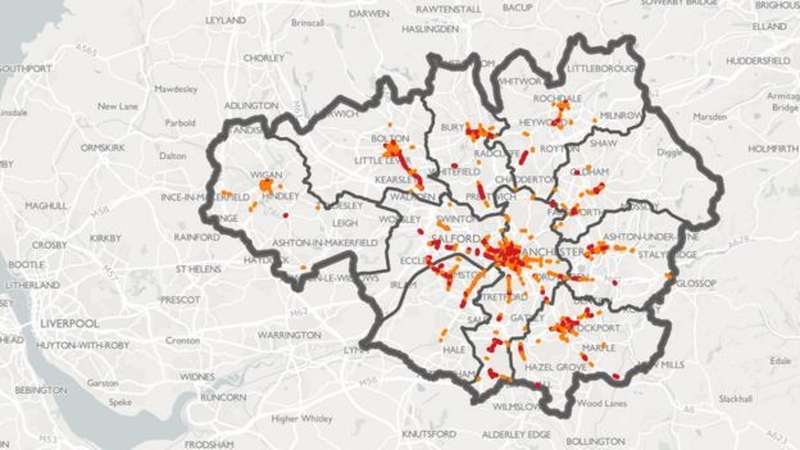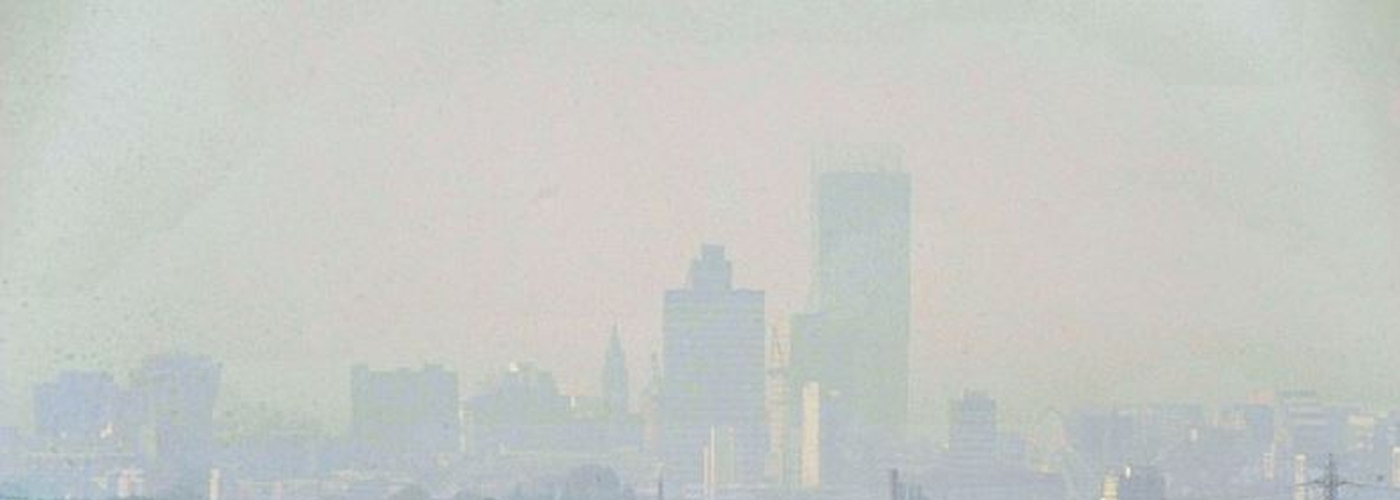Critics have called it a congestion tax by stealth
In amongst the announcements about carbon-neutral public transport and Andy Burnham making friends at COP, the metaphorical wheels have been turning on preparing the whole of the Greater Manchester region to become a Clean Air Zone. Special cameras are going up, signs are being prepared and reminders are being sent to certain vehicle owners that they need to clean up or they will be liable for a daily charge.
But while preparations are being made, the exhaust fumes of an argument that has been quietly idling away for a while now are polluting Andy’s ambitions to be the cleanest, greenest city around.
I assure him that only the most polluting older vehicles are charged in a clean air zone
Last week, Nathan Evans wrote an article for Conservative Home entitled "Burnham’s congestion charge will be a disaster for businesses in Greater Manchester". In the article, he called the Clean Air charge, “a Congestion Tax masquerading as a Clean Air Zone across the whole of Greater Manchester."
"The Greater Manchester Combined Authority,” he writes, “under instruction from Burnham, is set to implement the largest road charging area in the world”.

Those of you wondering what the GM Clean Air Zone (often called CAZ) is might want to do a hop, skip and a jump down to the feature box at the end of this article for the details. The TL;DR version is that all commercial vehicles (including those belonging to sole traders) will be liable for a daily charge to drive anywhere in Greater Manchester if they are not up to emissions standards.
Not just the city centre but all ten boroughs will be levying the charge. In practice this means (roughly) that diesel vehicles will be classed as non-compliant while a few petrol vehicles and all electric vehicles will pass muster. The idea is to encourage vehicle owners to speed up their plans to replace current vehicles with cleaner ones if they have not already done so. Private vehicles are not included in the Clean Air Zone. The daily charge ranges from £7.50 for a taxi up to £60 for heavy goods vehicles.
So is it a congestion charge?
Critics of the Clean Air Zone often call it a "congestion charge by stealth". This was the Conservative candidate for GM Mayor Laura Evans' favourite campaign issue, after policing. In fact, it became such an irritant to the Labour team that they considered referring her to the Electoral Commission for making untrue statements.
In fact, members of Laura's own party agreed with Mr Burnham on the matter. Replying to a question from her colleague Mark Logan, The Conservative Parliamentary Under-Secretary Rebecca Pow said: “I assure him that only the most polluting older vehicles are charged in a clean air zone, and it is not a congestion charge; the Greater Manchester plan does not include charging private cars, and the evidence provided by Manchester authorities to date shows that this is not needed.”
The insistence by Laura and Nathan Evans that it is a congestion charge probably plays on the proposal that was put forward in 2008 - and rejected by over 70% of people who took part in the vote. The obvious unpopularity of a congestion charge has clear political benefits here. At the time, Andy Burnham said: "We are not prepared to allow candidates in this election to play the Trump handbook and say whatever they like without being held to account."

A congestion charge and clean air zone have different aims. A congestion charge aims to reduce the amount of traffic on the road, while a clean air zone aims to change the type of vehicles on the road. In theory, if all drivers were able to switch over to electric easily, then there could be the same amount of traffic on the road pre- and post-CAZ coming in to play. Clean air zones also operate 24/7, while congestion charges typically only operate in peak hours, with the hope of encouraging people to spread the journeys they make more evenly throughout the day.
So, while politicians try to use the "congestion charge" tag to throw mud at one another, it seems that for the van drivers and other commercial vehicle operators worried by the CAZ, a congestion charge would actually be preferable to a clean air zone. For many, deliveries and jobs could be rerouted to off-peak parts of the day, and, as congestion charges also typically include private vehicles, the financial burden would be spread between more vehicles, meaning cheaper charges.
The GM Clean Air Zone might not be a congestion charge, but that isn't the get-out card some people think it is. The economic effects might be even far more wide-ranging than the charge rejected in 2008.

Is the CAZ down to Andy Burnham?
The answer to this one is yes and no. The top-line answer is that the CAZ was mandated by the Conservative government. In 2017, national government placed a legal responsibility on local authorities to develop Clean Air Plans to tackle nitrogen dioxide (NO2) exceedances at the roadside. This was because the government had been sued several times for not reducing illegal NO2 levels and were then legally obliged to lower them.
Nathan Evans writes: "We have a mayor who blames the Government. After all, no one told him how to 'interpret' the original government request to clean up."
In fact, the government identified charging Clean Air Zones as the benchmark measure that would achieve the NO2 limit values in the shortest possible time. Local authorities were instructed to implement a charging Clean Air Zone unless they could identify alternative measures which are at least as effective in reducing NO2 air pollution, and as quickly. It is true that smaller cities such as Southampton did manage to present a business case that didn't require a CAZ, but as Manchester has the highest levels of NO2 outside of London, the only realistic way to achieve the government's aim was through a CAZ.
However, the GMCA could have imposed the CAZ onto a much smaller area - Nathan Evans is right to state that the size of the CAZ is down to Mr Burnham. The CAZ in Birmingham is roughly five miles across - i.e. only covers the city centre. However, that particular CAZ also includes private vehicles, so commuters and shoppers also have to pay the charge. The GM scientific modelling found that the most reduction of NO2 could be achieved by focusing on vans and larger vehicles, but the data is had to parse.
One effect the clean air team were keen to avoid was a kind of doughnut effect, where vehicles avoided the city centre as much as possible and instead created a ring of even higher pollution in the surrounding suburbs - areas where people live and relax and, of course, there are many more schools. By choosing to make the whole of Manchester a CAZ, this lessened the chance of creating pockets of even higher NO2 emissions.

Is the CAZ bad for business?
Nathan Evans' final claim is that the CAZ will be bad for business. It is true that many businesses are extremely stretched during the pandemic and every extra burden is a burden too many. Some are still doing well - and a flat fee will act as a regressive charge that will open up the gulf between them and those struggling. Large businesses will be able to dominate smaller ones even more effectively as they soak up these charges that leave independent businesses struggling.
Another worry is more to do with a kind of "chilling effect" that it might have over other industries. The night-time economy might suffer if there are fewer private hire taxis for example (most private hire vehicles are owned by their drivers who would be responsible for paying the daily charge). It is thought that Uber might bring in a green surcharge which will go towards helping their drivers replace their vehicles with electric ones, but a huge company like that can afford to do so - while a tiny local firm cannot. Improved public transport and night services might be able to offset this potential problem.
On the positive side, analysis by CBI Economics claims that the city could see an annual economic benefit of £28m driven by preventing 290 premature deaths each year and gaining 60,000 working days per annum from reduced staff absences. A pretty brutal way to look at things but important nonetheless.
At a recent press conference, Andy Burnham said: "Of course we recognise the financial challenge ahead for people if they have to change their vehicle. Later this month we will launch a clean air support service for businesses and individuals, which will be run here by our Growth Company. What it will do is provide a range of advice to people on how they can make the change without it posing any risk to jobs or businesses. As we go forward we will particularly look at people who need to upgrade vans. We believe vans will be the single biggest challenge we face as part of this.
"Often small businesses, with one or two vans - we believe they will need a lot of support. The message I want to give to them today is: there’s 18 months to go, we will be putting in place that support. We want to make sure that you’re not only able to protect yourself, but to enhance your business as a result of this, ending up with a new vehicle that’s cheaper to run. That will bring long-term benefits to businesses but we recognise the challenge. We will continue to see what we can do to increase the range of offers available to van owners in Greater Manchester so they’re able to make the shift."
The GMCA currently has funding from the government to offer grants of around £4,500 (depending on vehicle) to businesses that want to replace their vehicles. Many vehicle owners have claimed this is just not enough to keep their businesses sustainable.
The Clean Air Zone Financial Support Scheme
The Clean Air Zone Financial Support Scheme will help people to either replace or retrofit non-compliant vehicles so that they meet emissions standards.
Funding will initially be targeted to support smaller businesses, sole traders, the voluntary sector and private owners to upgrade to compliant vehicles. Financial support will be available as a lump sum grant, contribution towards vehicle financing, or a combination of the two. The amount of support available will depend on the vehicle type and size.
The scheme will open for applications from HGV owners from 30 November 2021. Other eligible vehicle applications will follow in late January 2022.

So what will happen in the future?
Laura Evans has also claimed that the CAZ will open the door for a genuine congestion charge, levied upon all vehicles – even private cars. Indeed some environmental groups expressed concern that without plans to include private vehicles the CAZ could not get close enough to achieving its aims. A taxi driver we spoke to expressed a similar fear to Mrs Evans, that the charge would be expanded to “once they see how much money they can make”.
At the sustainable transport hustings, Mr Burnham said that a congestion charge "wouldn't be fair". Are recently he said "It’s not a congestion charge and it never will be whilst I am mayor. It’s different - it’s a clean air zone which is encouraging people to change their vehicles to become compliant."
GMCA cannot expand the remit of the CAZ without public consultation, but even if it did, the lead on Clean Air Andrew Western says, “We absolutely won’t charge for private vehicles because the modelling says it is unnecessary.” He actually thinks the GM CAZ as currently designed may only apply for a few years: “Once the NO2 levels have reached legal limits it could be removed, though there still would have to be a conversation about national clean air policy. Everyone is still ignoring particulate pollution.”
The idea that the CAZ is a revenue-raising scheme is also more complicated than at first glance. In fact, the idea of the original congestion charge proposal, back in 2008, was to fund the radical reorganisation and improvement of Manchester’s public transport system. However, this required the voters to trust that the council would be able to take the money raised and make a decent transport system with it. Readers, they did not.
But that is not the aim here. Around election time, a spokesman from the GMCA told Confidentials: “We’d be very happy if we never collected a penny of this, if that meant every vehicle had been replaced with a cleaner, greener vehicle.” Andrew Western echoed that sentiment when he told us that the forecast revenue from the charge is “not huge amounts” and that any money collected would go back towards “transport priorities”.
However, it seems if the revenue forecasts are correct, the first thing the CAZ will have to aim for is covering its own costs. GMCA has agreed a deal with French firm Egis to administer the zone. The £48.1 million, five-and-a-half-year deal covers the provision of infrastructure and will involve the installation of around 850 automatic number plate recognition cameras.
Meanwhile, AECOM has agreed on a £720,000 contract to monitor air quality across the 10 council areas involved in the scheme, collecting samples from monitoring sites and providing data to measure the effects of the initiative. Sign specialist McGann will be paid £3m to produce signs letting drivers know they are entering a CAZ and the signs are going up across Manchester even now.
The money for the cameras has already been provided by the government, who will also be collecting the money raised from the charges and any fines and in theory redistributing it to the council. GMCA is not a charging body so will not make any money from the scheme.
While we've covered some of the political and economic implications of the CAZ, in the next week we will be looking at more personal stories of those affected.
Find out more about the Greater Manchester Clean Air Zone at cleanairgm.com
Clean Air Zone - the essentials
Commercial vehicles will be charged per day to drive within Greater Manchester if they do not have engines that meet emissions requirements. The amount charged will depend on the vehicle and the zone covers every borough in Greater Manchester – that’s 493 sq miles. The Clean Air Zone boundary will follow the administrative boundary of GM as closely as possible. It includes local roads but does not include motorways and major trunk roads which are managed by National Highways (formerly Highways England). Drivers are advised to check the map at cleanairGM.
The Clean Air Zone will come into operation on 30 May 2022 and will not include private cars. The Zone will operate 24 hours a day, seven days a week, all year round. The charge would be imposed per vehicle, per "charging day" (midnight to midnight), however much a vehicle drives within the Zone in that 24-hour period.
As the charge is dependent on emissions, electric vehicles will not be charged and some other categories of vehicles may also be exempt. Owners are encouraged to check the status of their vehicles on the Clean Air GM website. The charge will be made when vehicles drive, aided by Automatic Number Plate Recognition (ANPR) cameras, and the charge can be paid up to seven days in advance or seven days in arrears.
The following daily charges will apply for owners of non-compliant vehicles travelling in the Greater Manchester Clean Air Zone.
· Buses and heavy goods vehicles, Euro V diesel or older engine – £60 (from 30 May 2022)
· Coaches, Euro V diesel or older engine – £60 (from 1 June 2023)
· Taxis and private hire vehicles, Euro 5 or older (diesel) and Euro 3 or older (petrol) engine – £7.50 (from 30 May 2022; temporary exemption for most Greater Manchester-licensed vehicles until 1 June 2023)
· Vans (light goods vehicles), Euro 5 or older (diesel) and Euro 3 or older (petrol) engine – £10 (from 1 June 2023)
· Minibuses, Euro 5 or older (diesel) and Euro 3 or older (petrol) engine - £10 (from 1 June 2023)
· Motorcaravans (motorhomes/campervans), Euro 5 or older (diesel) and Euro 3 or older (petrol) engine - the daily charge and date of introduction will depend on the tax class of the vehicle.
If the daily charge for a non-compliant vehicle isn’t paid, there will be a liability to pay a Penalty Charge Notice (PCN) of £120 in addition to the unpaid daily charge. This would be reduced to £60 if paid within 14 days.

















